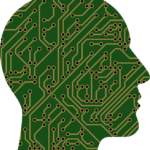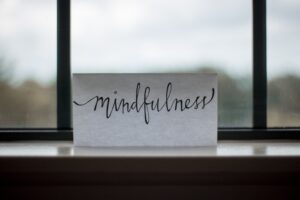By Serge Prengel
This article is part 3 of a continuing series about Active Pause. In part 2, I showed how the pause is part and parcel of the process of integrating our experience. Here, I will be describing it as a redefining moment. It is a perspective I like to share with clients, to put our work in context.
 As a concrete example, I will use a situation described by Mary Hendricks Gendlin. A first-time mother is in the hospital shortly after giving birth to her daughter. Her husband had to leave right after birth, so she is by herself when the hospital staff tells her that the baby has jaundice. They want to give the baby a shot. It doesn’t feel quite right to her, so she does not rush into it and questions the staff. Their arguments do not convince her. However, the hospital staff is persistent. The mother experiences herself as alone against the weight of medical wisdom and authority. It is against such pressure that she decides against the shot.
As a concrete example, I will use a situation described by Mary Hendricks Gendlin. A first-time mother is in the hospital shortly after giving birth to her daughter. Her husband had to leave right after birth, so she is by herself when the hospital staff tells her that the baby has jaundice. They want to give the baby a shot. It doesn’t feel quite right to her, so she does not rush into it and questions the staff. Their arguments do not convince her. However, the hospital staff is persistent. The mother experiences herself as alone against the weight of medical wisdom and authority. It is against such pressure that she decides against the shot.
Later, the mother finds out that her decision made sense medically. However, she does not have that information at the time she is in the hospital. In this article, what matters is to understand why she does with the limited information she has, in the context of unrelenting pressure from the medical staff.
What she does is take a pause. At a gut level, she feels a deep sense of uneasiness. Deep, but fuzzy: she’s not yet able to articulate what it is. All she knows from previous experience is that it makes sense to take a pause when she starts sensing something like that.
Taking a pause allows her to give more attention to what is still murky and faint. It enables her to notice the pressure. To you, the reader, this may seem evident. It had not been apparent to her before. Think about it from her perspective. You’re in the hospital, people are taking care of you, and telling you what to do is part of taking care of you. What could be more reasonable?
As she pauses, she starts to experience things differently. She no longer takes it for granted that she has to follow instructions. Now, she perceives the situation as a confrontation, with an overhanging sense of threat. The risk is significant: we’re talking about the health of a newborn child. The mother is alone against the medical staff.
This mother was Mary Hendricks Gendlin herself. In her retelling of the story, she emphasized how the new mother was alone against the staff, the hospital, the medical world. She was alone against what felt like the weight of collective wisdom: trust medicine. So, Mary called what she did “the revolutionary pause.” She saw such moments as an opportunity for individuals to stand up for themselves against societal norms that are all the more oppressive because the oppression is hidden.
Emphasizing the social and political dimensions does not mean that Mary was oblivious to the psychological aspect. To the contrary. As a psychologist and a Focuser, Mary was aware of the complexities of inner experience. She wanted to put the psychological within a broader context. The struggle to be oneself is not just intrapersonal or interpersonal. It also has to do with the society we live in and the pressures this imposes on us. These pressures affect our individual experience, whether we are conscious of them or not.
Let us go now back to re-examine what happens in the story told by Mary, from the perspective of it being a redefining moment.
In the beginning, she is emotionally flooded. This is understandable. It feels excruciating to go against accepted wisdom when the stakes are high. Pressure and fear prevent us from seeing that there may be an opportunity to make a choice. We tend to be reactive rather than develop a thoughtful response to the challenge. Responding, as opposed to reacting, requires taking some time to gain a broader perspective and consider options.
The Emerging Self
As the saying goes, what doesn’t kill you makes you stronger. If you don’t collapse in the face of unrelenting pressure, you experience yourself as having agency.
The mother decides that she does not have to rush into giving the baby a shot for jaundice. As she stands up against the pressure, she experiences a strong sense of self. She describes it as a revolutionary resistance to oppression. Politically, this is what happened when the American colonies resisted English oppression and emerged as a country. This concept can just as well be described in psychological terms. It involves the sense that “I” exist and “I want.” This is not an abstract notion but a deeply felt experience.
The stakes in this example are high. So, we have no trouble thinking of it as a “defining moment.” It is a moment the mother will remember long afterward, as the moment where she stood up against authority. She took a risk to do what she felt was best for her daughter, as opposed to doing what she was told.
In this case, the sense of self coalesced around the experience of saying no to the shot. What makes it defining is not a specific decision. If the mother had eventually decided to yield to medical advice after pausing, it would still be a defining moment. Her experience would have been that of feeling overwhelmed by the risk, not wanting to take that responsibility, wanting to be sheltered by the voice of authority. That too would be a deeply felt defining moment, anything but an abstraction.
It comes to us more naturally to call ‘defining moments’ those moments when we break from the mold. But it is equally defining, in the sense of helping us know who we are, to have experiences where we realize that we do not have the stuff it takes to break from the mold.
Such moments are a breakthrough, a rupture, a paradigm shift. Compared to dramatic moments such as the one Mary described, most of what happens after we pause in our everyday life is relatively trivial. Yet, I like to think of what happens after any pause as a “redefining moment.” Not because it changes your whole outlook on life. But because it makes you reconsider your relationship with what is happening to you.
In the flow of moment-by-moment experience, a mindful pause is a rupture of continuity. At this moment, there is a reassessment, a conscious reorientation. No matter how small the shift, and even if there is no actual change, it is an opportunity to have the felt experience of “I am” and “I decide what to do.” Or: “I face the situation; therefore, I am.”
I also want to clarify that, when I talk about “sense of self” and “defining moment,” I do not mean that there was no sense of self before. I am talking about the unfolding of our experience of “self,” as we redefine ourselves based on how we respond to our circumstances.
These are not abstractions
Words such as meaning, purpose, self, or defining moments are not philosophical abstractions. They refer to deeply felt experiences that we notice when we pay attention to our experience moment by moment.
The sense of intense pressure that the young mother feels in the story is not an abstract concept. We are talking about genuine fear. It is the crucible of intense emotions that shapes the emerging sense of self.
Mindful engagement with life entails experiencing painful feelings, as opposed to being dissociated from them. It involves experiencing the “fight or flight” reaction that comes naturally to us when we face significant threats. Millions of years of evolution have deeply ingrained “fight or flight” in our direct ancestors, as well as in the more primitive animals that preceded them. The ability to confront danger, or run away from it if it is overwhelming, has enormous survival value. So, it is part of our genetic heritage, something that is difficult to override.
 The situation depicted in the story is a significant threat. We are talking about the health of a precious newborn child. Under intense danger, our nervous system goes into emergency mode. Knee-jerk reactivity comes from the “rapid response” part of our nervous system, as opposed to the circuits that process more complex information. Think about it this way. Imagine you are in antelope, and you smell a lion. It is much more useful for you to automatically run away than to start exploring whether or not this smell might be misleading. Otherwise, you might get killed and eaten before you have found an answer to the issue.
The situation depicted in the story is a significant threat. We are talking about the health of a precious newborn child. Under intense danger, our nervous system goes into emergency mode. Knee-jerk reactivity comes from the “rapid response” part of our nervous system, as opposed to the circuits that process more complex information. Think about it this way. Imagine you are in antelope, and you smell a lion. It is much more useful for you to automatically run away than to start exploring whether or not this smell might be misleading. Otherwise, you might get killed and eaten before you have found an answer to the issue.
Reactivity is a great advantage when there is a real danger. However, in our ordinary lives, the threats we face are often not situations that require this kind of hair-trigger reactivity. More often than not, it works better for us to take a moment to assess the situation. Doing this means being proactive rather than reactive.
Overriding the reactive mode
What is it that enables us to avail ourselves of this great resource, pausing, in times when we experience threat?
 There has to be a part of us, even a tiny part, that can step back: “Wait a minute!” It is necessary to interrupt the circuit of reactivity to give ourselves a chance to elaborate a potentially better response.
There has to be a part of us, even a tiny part, that can step back: “Wait a minute!” It is necessary to interrupt the circuit of reactivity to give ourselves a chance to elaborate a potentially better response.
In Mary’s story, what made it possible for the young mother to override her reactivity? She had developed the ability to be mindful. In her case, it came from the practice of Focusing. Over time, she had developed the ability to pay attention to her felt sense, very subtle information coming from inside. Thus, when she was talking to the hospital staff, she was able to experience a subtle felt sense, the sense that something didn’t quite feel right. It’s a subtle sense that most of us don’t pay attention to because it doesn’t come with the loudness and the clarity of an explicit warning.
It is hard to ignore flashing red lights and loudspeakers blaring: “Watch it! Danger!” It is much more difficult to notice some kind of a subtle queasy feeling in your stomach. Especially when the situation is so intense that paying attention to subtle sensations might feel like wasting precious time. The natural urge then is to concentrate on the threat, not the inner experience.
But Mary was accustomed to paying attention to this kind of felt sense. She knew, at a gut level, that attending to a felt sense improved her ability to respond to the situation. She knew from repeated experience that the pause didn’t have to last very long for it to be effective. It is impressive how fast you get information from the felt sense once you stop ignoring it and pay attention to it.
You take a moment to be attentive to that queasy feeling in your stomach. Right away, you get some sense that “something’s not right here.” You don’t know what is not right, but you know it’s good to attend to it.
It’s a “Wait a minute!” moment. You feel: “Something’s not quite right. I need a moment to sense into it.” It’s not that you know the specifics of what is not right. Not yet. All you know is that it’s okay to take a moment. It’s more than okay. You need to take a moment. So, you push back against internal pressure or pressure from others. Firmly. Gently if you can, more forcefully when needed. You are not doing this to be negative, rebellious, rejecting other people’s suggestions. You simply need to make a space to hear yourself sense and feel and think.
The theory is straightforward: All you have to remember is that you need to take a mindful pause when there is a threat or pressure. In practice, it is not so easy to do when the situation is intense. What makes it difficult is that it takes overwriting the potent reactive mechanism that millions of years of evolution have honed to perfection. Therefore, the pause is something that you have to train for so that it is available to you as a resource when you need it most.
In the story, what helped the mother was her previous training in Focusing. Practicing mindfulness is an excellent way to train our nervous system to override reactivity. Essentially, the practice of mindfulness enables us to notice our reactivity and to shift our attention.
Practicing mindfulness develops our ability to engage the nervous system circuits that can assess information in a more sophisticated way than the reactive circuits. Mindfulness practice, in general, is beneficial to help override reactivity. Focusing is especially helpful in developing our capacity to be mindful in everyday life.
My next article will discuss getting in touch with experience as an embodied, mindful process.
Serge Prengel, LMHC, is a graduate of France’s Sorbonne University and HEC Business School. He is certified in Focusing, in Core Energetics and in Somatic Experiencing. He also draws from Systems-Centered theory. He started and operated an ad agency in New York for many years.
Photo Credits
Fog Lake Thomas B on Unsplash
Gazelle Vincent van Zalinge on Unsplash
Circuitry Gordon Johnson Pixabay
Mindfulness Lesly Juarez on Unsplash









